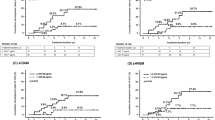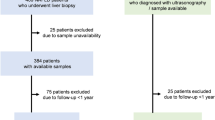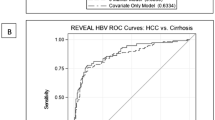Abstract
Background
The majority of hepatocellular carcinoma (HCC) cases occur in the presence of cirrhosis. Biomarkers of cirrhosis-associated immune dysfunction such as CD8+ T cell cytokines could aid HCC risk assessment.
Methods
CD8+ T cell cytokines were determined in pre-diagnostic serum in two studies including 315 HCC case–control pairs in the Shanghai Cohort Study (SCS) and 197 pairs in the Singapore Chinese Health Study (SCHS). Conditional logistic regression was used to estimate odds ratio (OR) and 95% confidence interval (CI) for HCC with levels of five cytokines—soluble CD137 (sCD137), soluble Fas (sFas), perforin, macrophage inflammatory protein 1-beta (MIP-1β), and tumour necrosis factor alpha (TNF-α).
Results
sCD137 levels were significantly higher in HCC cases than controls in both cohorts (Ps < 0.001). Compared with the lowest quartile, multivariable-adjusted ORs (95% CI) of HCC for the highest sCD137 quartile were 3.79 (1.73, 8.30) in the SCS and 3.49 (1.44, 8.48) in the SCHS. The sCD137-HCC association was independent of hepatitis B seropositivity and follow-up time. No other cytokine was consistently associated with HCC risk.
Conclusion
sCD137 was associated with higher risk of HCC in two studies nested in general population cohorts. sCD137 may be a long-term risk marker of HCC development.
This is a preview of subscription content, access via your institution
Access options
Subscribe to this journal
Receive 24 print issues and online access
$259.00 per year
only $10.79 per issue
Buy this article
- Purchase on Springer Link
- Instant access to full article PDF
Prices may be subject to local taxes which are calculated during checkout

Similar content being viewed by others
Data availability
The data that support the findings of this study are available from the corresponding author upon reasonable request.
Code availability
The computer code that support the findings of this study is available from the corresponding author upon reasonable request.
References
Ferlay J, Colombet M, Soerjomataram I, Parkin DM, Piñeros M, Znaor A, et al. Cancer statistics for the year 2020: an overview. Int J Cancer. 2021. https://doi.org/10.1002/ijc.33588.
Bray F, Ferlay J, Soerjomataram I, Siegel RL, Torre LA, Jemal A. Global cancer statistics 2018: GLOBOCAN estimates of incidence and mortality worldwide for 36 cancers in 185 countries. CA Cancer J Clin. 2018;68:394–424.
El-Serag HB, Rudolph KL. Hepatocellular carcinoma: epidemiology and molecular carcinogenesis. Gastroenterology. 2007;132:2557–76.
McGlynn KA, Petrick JL, El-Serag HB. Epidemiology of hepatocellular carcinoma. Hepatology. 2021;73:4–13.
Massarweh NN, El-Serag HB. Epidemiology of hepatocellular carcinoma and intrahepatic cholangiocarcinoma. Cancer Control. 2017;24:1073274817729245.
Ringelhan M, Pfister D, O’Connor T, Pikarsky E, Heikenwalder M. The immunology of hepatocellular carcinoma. Nat Immunol. 2018;19:222–32.
Albillos A, Martin-Mateos R, Van der Merwe S, Wiest R, Jalan R, Álvarez-Mon M. Cirrhosis-associated immune dysfunction. Nat Rev Gastroenterol Hepatol. 2022;19:112–34.
Lan T, Chen L, Wei X. Inflammatory cytokines in cancer: comprehensive understanding and clinical progress in gene therapy. Cells 2021;10:100.
Ohishi W, Cologne JB, Fujiwara S, Suzuki G, Hayashi T, Niwa Y, et al. Serum interleukin-6 associated with hepatocellular carcinoma risk: a nested case-control study. Int J Cancer. 2014;134:154–63.
Trichopoulos D, Psaltopoulou T, Orfanos P, Trichopoulou A, Boffetta P. Plasma C-reactive protein and risk of cancer: a prospective study from Greece. Cancer Epidemiol Biomark Prev. 2006;15:381–4.
Ross RK, Yuan JM, Yu MC, Wogan GN, Qian GS, Tu JT, et al. Urinary aflatoxin biomarkers and risk of hepatocellular carcinoma. Lancet. 1992;339:943–6.
Yuan JM, Ross RK, Wang XL, Gao YT, Henderson BE, Yu MC. Morbidity and mortality in relation to cigarette smoking in Shanghai, China. A prospective male cohort study. JAMA. 1996;275:1646–50.
Thomas CE, Luu HN, Wang R, Adams-Haduch J, Jin A, Koh WP, et al. Association between dietary tomato intake and the risk of hepatocellular carcinoma: the Singapore Chinese Health Study. Cancer Epidemiol Biomark Prev. 2020;29:1430–5.
Hankin JH, Stram DO, Arakawa K, Park S, Low SH, Lee HP, et al. Singapore Chinese Health Study: development, validation, and calibration of the quantitative food frequency questionnaire. Nutr Cancer. 2001;39:187–95.
Rundle AG, Vineis P, Ahsan H. Design options for molecular epidemiology research within cohort studies. Cancer Epidemiol Biomark Prev. 2005;14:1899–907.
Yuan JM, Ross RK, Stanczyk FZ, Govindarajan S, Gao YT, Henderson BE, et al. A cohort study of serum testosterone and hepatocellular carcinoma in Shanghai, China. Int J Cancer. 1995;63:491–3.
Koh WP, Robien K, Wang R, Govindarajan S, Yuan JM, Yu MC. Smoking as an independent risk factor for hepatocellular carcinoma: the Singapore Chinese Health Study. Br J Cancer. 2011;105:1430–5.
WHO Expert Consultation. Appropriate body-mass index for Asian populations and its implications for policy and intervention strategies. Lancet. 2004;363:157–63.
Lash TL, VanderWeele TJ, Haneuse S, Rothman KJ. Modern epidemiology. 4th ed. Philadelphia, PA: LWW; 2021.
VanderWeele TJ, Knol MJ. A tutorial on interaction. Epidemiol Methods. 2014;3:33–72.
Galle PR, Foerster F, Kudo M, Chan SL, Llovet JM, Qin S, et al. Biology and significance of alpha-fetoprotein in hepatocellular carcinoma. Liver Int. 2019;39:2214–29.
Luu K, Shao Z, Schwarz H. The relevance of soluble CD137 in the regulation of immune responses and for immunotherapeutic intervention. J Leukoc Biol. 2020;107:731–8.
Wong HY, Schwarz H. CD137/CD137 ligand signalling regulates the immune balance: a potential target for novel immunotherapy of autoimmune diseases. J Autoimmun. 2020;112:102499.
Michel J, Schwarz H. Expression of soluble CD137 correlates with activation-induced cell death of lymphocytes. Cytokine. 2000;12:742–6.
Labiano S, Palazón A, Bolaños E, Azpilikueta A, Sánchez-Paulete AR, Morales-Kastresana A, et al. Hypoxia-induced soluble CD137 in malignant cells blocks CD137L-costimulation as an immune escape mechanism. Oncoimmunology. 2016;5:e1062967.
Gauttier V, Judor JP, Le Guen V, Cany J, Ferry N, Conchon S. Agonistic anti-CD137 antibody treatment leads to antitumor response in mice with liver cancer. Int J Cancer. 2014;135:2857–67.
Furtner M, Straub RH, Krüger S, Schwarz H. Levels of soluble CD137 are enhanced in sera of leukemia and lymphoma patients and are strongly associated with chronic lymphocytic leukemia. Leukemia. 2005;19:883–5.
Tu TH, Kim CS, Kang JH, Nam-Goong IS, Nam CW, Kim ES, et al. Levels of 4-1BB transcripts and soluble 4-1BB protein are elevated in the adipose tissue of human obese subjects and are associated with inflammatory and metabolic parameters. Int J Obes. 2014;38:1075–82.
Weigand K, Peschel G, Grimm J, Luu K, Schacherer D, Wiest R, et al. Soluble CD137 is a novel serum marker of liver cirrhosis in patients with hepatitis C and alcohol-associated disease etiology. Eur J Immunol. 2022;52:633–45.
Acknowledgements
We thank the Singapore Cancer Registry for the identification of incident cancer cases among participants of the Singapore Chinese Health Study and Siew-Hong Low of the National University of Singapore for supervising the fieldwork of the Singapore Chinese Health Study. We also thank Ms. Xue-Li Wang of the Shanghai Cancer Institute for supervising the field work of the Shanghai Cohort Study and the Shanghai Cancer Registry for assistance with identification of cancer outcomes in the Shanghai Cohort Study. This project used the UPMC Hillman Cancer Center Cancer Biomarkers Facility: Luminex Core Laboratory.
Funding
The Shanghai Cohort Study was supported by the National Institutes of Health (NIH) of the United States (grants # R01CA043092, R01CA144034, and UM1CA182876), and the Singapore Chinese Health Study was supported by NIH (grants # R01CA080205, R01CA144034, and UM1CA182876). The current work was also partially supported by the NIH grants # R01CA255809 and P30CA047904. CET is supported through a NIH training grant (grant # T32 CA186873). The content is solely the responsibility of the authors and does not necessarily represent the official views of NIH.
Author information
Authors and Affiliations
Contributions
The work reported in the paper has been performed by the authors, unless clearly specified in the text. CET: conceptualisation, formal analysis, visualisation, writing of the original draft of the manuscript, writing—reviewing and editing. JJA, ALK, BD: conceptualisation, methodology, writing—reviewing and editing. HNL: conceptualisation, writing—reviewing and editing. AJ: formal analysis. W-PK, Y-TG: data curation, resources, writing—reviewing and editing. JA-H: data curation, project administration. RW: formal analysis. AL: data curation, writing—reviewing and editing. JB: investigation, writing—reviewing and editing. J-MY: conceptualisation, data curation, resources, formal analysis, funding acquisition, supervision, writing—reviewing and editing.
Corresponding author
Ethics declarations
Competing interests
The authors declare no competing interests.
Ethics approval and consent to participate
The Shanghai Cohort Study has been approved by the Institutional Review Boards of the Shanghai Cancer Institute and the University of Pittsburgh. The Singapore Chinese Health Study has been approved by the Institutional Review Boards of the National University of Singapore and the University of Pittsburgh. Informed consent was obtained from all participants. The present study has been approved by the University of Pittsburgh Human Research Protection Office and was conducted in accordance with the Declaration of Helsinki.
Additional information
Publisher’s note Springer Nature remains neutral with regard to jurisdictional claims in published maps and institutional affiliations.
Rights and permissions
Springer Nature or its licensor (e.g. a society or other partner) holds exclusive rights to this article under a publishing agreement with the author(s) or other rightsholder(s); author self-archiving of the accepted manuscript version of this article is solely governed by the terms of such publishing agreement and applicable law.
About this article
Cite this article
Thomas, C.E., Adibi, J.J., Kuipers, A.L. et al. Soluble CD137 and risk of hepatocellular carcinoma: nested case–control studies in cohorts in Shanghai and Singapore. Br J Cancer 128, 2081–2088 (2023). https://doi.org/10.1038/s41416-023-02223-z
Received:
Revised:
Accepted:
Published:
Issue Date:
DOI: https://doi.org/10.1038/s41416-023-02223-z



